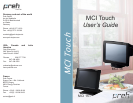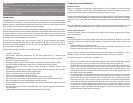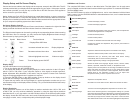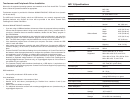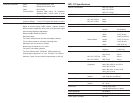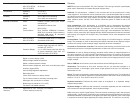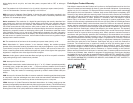
Power Dissipation MCI 15T C2RT2 21 W max.
MCI 15T C1RT4 & 40 W max.
MCI 15T C2RT4
Temperature Operating 0°C to 40°C
Storage -30°C to 60°C
Humidity Operating 20% to 80% non-condensing
Storage 5% to 90% non-condensing
External Connections Power External +12VDC power pack, 5.5mm
miniature jack
Audio Standard 3mm Stereo Jack
Video HD15 (VGA)
Touch Interface Dual Interface USB/Serial Controller;
DB9F 9-pin connector (serial interface);
Standard USB series “B“ receptable
(detachable USB cable)
Connectivity MCI 15T C2RT4 2 x Standard USB series “A“ receptacle
(detachable USB cable)
MCI 15T C1RT4
POS Options Magstripe Reader 3 Track Reader with Power and Error
Indicator Light (Only MCI 15T C2RT4
and MCI 15T C1RT4).
Customer Display 2 x 20 VFD Display with Dual Axis (tilt
& swivel) Movement (Only MCI 15T
C2RT4 and MCI 15T C1RT4)
Additional features Power switch state memory
Digital on-screen display (OSD)
Rubber Wedge Sealed touchscreen
Hidden, software lockable controls
Direct access to brightness, audio mute, and video auto adjust
functions (bypass OSD)
Auto-Sensing Brightness Adjustment
Removable base
75mm VESA mounts on display chassis
Top or bottom access to countertop mounting holes
Kensington lock connection on chassis
Broad range of vertical tilt (-5º to +90º)
Two built-in 1W bafed speakers
Product Agency Approvals: UL, cUL, TUV(GS), FCC Class B
Warranty 3 Years warranty (In the US)
Glossary
AMTFT: Acronym for Active Matrix Thin Film Transistor. This is the type of liquid crystal display
panel used in essentially all computer at panel displays today.
Calibrate: For touchscreens, “calibrate” is the common term for the process that is really
“video alignment.” A touchscreen and its controller have a coordinate system that are usually
not identical to the coordinate system of the video display of the host computer. By displaying
reference points on the MCI Touch Monitor (through the calibration program) and touching
those reference points, the MCI Touch Monitor coordinate system is scaled to that of the
computer.
Color temperature: Color temperature is a simplied way to characterize the spectral
properties of a light source, and is the temperature you would heat a theoretical “black body”
source to radiate light of the same visual color. For example, “low” color temperature, like
3200°K, implies warmer (more yellow/red) light, while “high” color temperature, like 9300°K,
implies a cooler (more blue) light. Daylight has the 3200°K temperature mentioned near dawn
and evening, and a higher one during the day. The standard unit for color temperature is the
Kelvin (K).
Contrast Ratio: The ratio of the luminance of the display of a full white image to a full black
image. This parameter is useful in determining the relative sharpness of two displays-a higher
contrast ratio usually implies a sharper image, especially when text is displayed.
Controller or Touchscreen controller: The electronics that actually process the touch on the
touchscreen and sends out a digital representation of that touch to the host computer.
Emulation: As used in display technology, emulation mode means an image displayed at a
non-native resolution. For your Preh MCI Touch Monitor and other 15” monitors, the common
emulation modes are 800 x 600 and 640 x 480. In emulation modes, a monitor cannot perfectly
display the image sent from the computer when the monitor pixel to image pixel ratio is not an
integral multiple.
Hub or USB hub: An electronic circuit that combines several USB signals into one.
Illuminance: The measure of how much luminous ux per unit area that impinges on a
particular surface, or how bright a point source of light appears to the eye. It is measured in
footcandles or in lux.
Kelvin: The scale of temperature measurement that begins at absolute zero. The increment of
temperature that one Kelvin represents is the same as that of the Celsius scale, but the scale
starts at -273.16°C. Thus 293°K is about 20°C or 68°F.
Keyboard emulation: Produces the same output as a keyboard, or a “keyboard wedge”
magnetic stripe reader.
Keyboard wedge: An MSR unit that connects to a computer keyboard port with a cable that
also connects the standard keyboard, thus a keyboard wedge.
LCD: Acronym for Liquid Crystal Display. The most common technology used in at computer
displays today. “Liquid crystal” molecules (a very complex chemical engineered for this function)
sandwiched between a combination of at glass color lters and polarizers, pass or block light
in response to electrical signals applied by the display electronics. The result is a very sharp,



